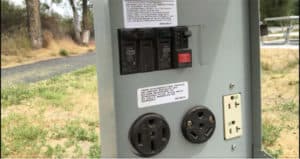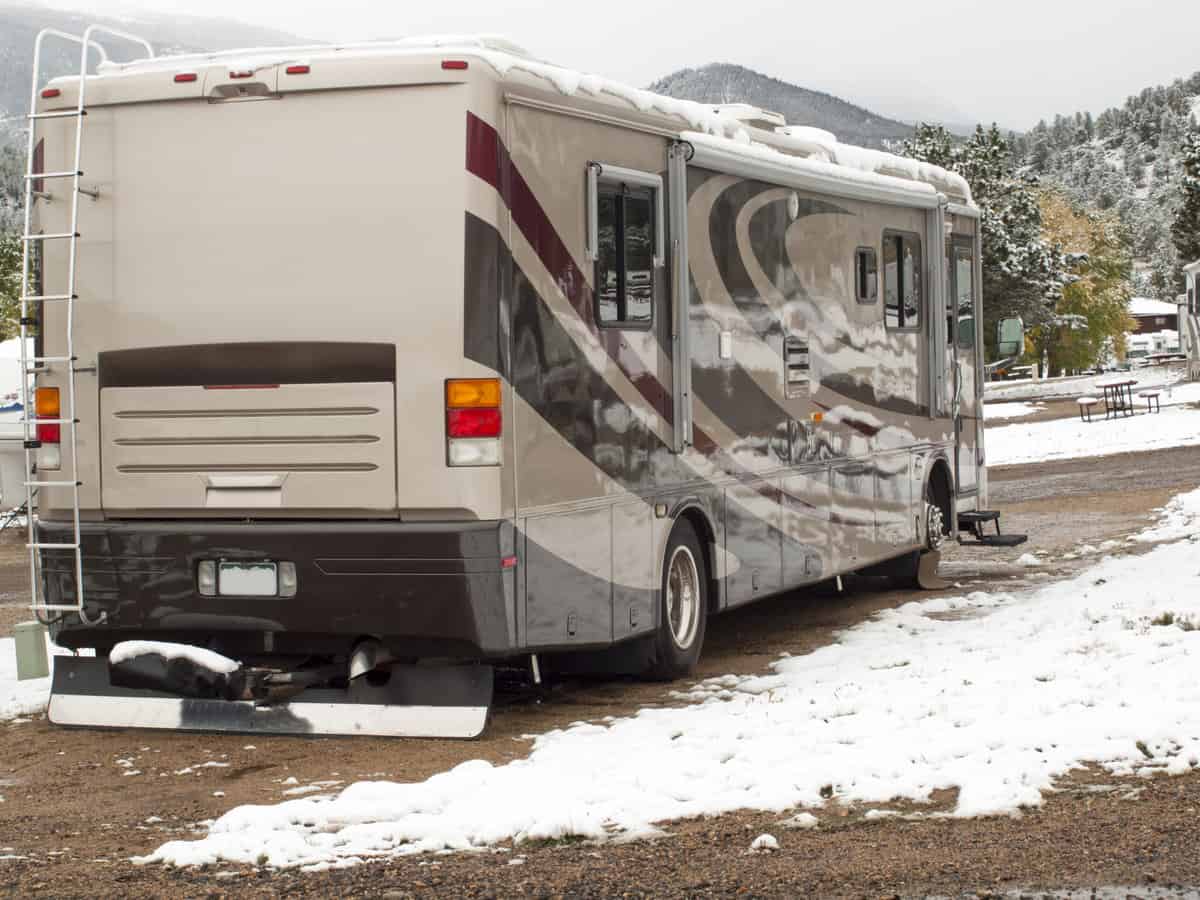I hate to break it to you, but summertime is almost over.
Okay, yes, technically it’s summer until 11:59 p.m. on September 21st, but it just doesn’t feel like summer once August is behind us. The kids will be back to school, the beaches will be deserted, and you’ll be thinking about winterizing your camper trailer.
If your vehicle’s battery often has no juice in the cold months, you may wonder how to keep it from dying over the winter.
The short answer is to keep its charge from dropping too low while avoiding overcharging.
If you want a more detailed answer as well as helpful pointers for avoiding a dead battery, read on.
What Happens If You Overcharge a Battery Too Much?
I prefer to liken a camper battery to one of the batteries most people are familiar with: a smartphone battery.
How many times have you been ready for bed only to see your phone’s battery is dying? Probably a handful. I know it’s happened to me many times.
What do you do? You plug in your phone and go to sleep. You know that by the time you wake up, you’ll have a fully-charged phone.
It turns out that what you’re doing is not helping. You’re overcharging the battery.
What does this mean? Well, the battery, even though it’s fully charged, still receives what are known as trickle charges. These aren’t full bursts of charging power because the battery no longer needs it. Don’t be fooled, though: the battery is still getting power.
When the battery receives trickle charges too many times, its internal chemistry begins to change for the worst. It doesn’t matter if it’s a phone battery or a camper battery. You’ve still damaged it.
The effects tend to be more severe with a camper battery, admittedly. By overcharging, you risk frying it. A fried battery probably won’t take a charge. If it does, it certainly won’t ever reach full power again. That means it’s back to square one since you’ll need a new battery.
What Happens If You Let the Battery Die All the Way?
Okay, you think. You don’t want to fry your camper battery, so you’ll use it as long as you can, maybe until it’s dead. This way, when you recharge it, it’ll take so long to power all the way up that overcharging won’t happen.
You can get away with this mentality once or twice. Anymore than that and you risk causing irreparable damage to your camper battery in yet another way. This time, the battery’s stability dies. You’re now left, once again, with a battery that won’t take a full charge.
No matter how many hours you let the battery sit, your camper will never be at 100-percent power. That’s pretty scary, isn’t it?
If you’ve let your camper battery die too many times, the only solution is to get a new one.
What’s the Happy Medium?
By this point, you understand that overcharging the battery is a no-no. Letting it die all the way and charging is also not recommended.
Listen, a battery is going to eventually lose its ability to induce and hold a charge regardless. If you care for it, you can prolong the inevitable for three, sometimes five years. If you don’t maintain the battery the way you’re supposed to, you could be shopping for new ones every six or 12 months.
When your batteries are being used during the active season, you should charge them once they reach 50-percent capacity. During the winter, when the batteries are not in your camper trailer, you should charge them even more often. You should not let the battery drop below 80 percent.
It may seem kind of counterintuitive to charge your batteries when they’re not even in use. What’s the point, right?
According to Jim Tomblin at TruckCamper, each month, you lose 10 percent of your battery capacity when they’re sitting idle. That’s permanent, by the way. Recharging will not restore battery capacity. If you were to winterize your camper in November and leave it until March, that’s four months, or 40 percent of the capacity gone for good.
How to Remove the Battery from Your Camper
If leaving your battery onboard your camper for the winter can cause both short-term and long-term damage, you’re going to want to take it out of your camper for the off-season. How do you do it?
First, it’s recommended you turn off the direct means of power to your trailer via a disconnect switch. Alternately (but not as conveniently), you can go through your camper and switch off all items one by one, including televisions, your refrigerator/freezer, other appliances, major electronics, and lights. The engine of your camper trailer should be off as well.
A few minutes after disconnecting from the power source, you can access the batteries through their hatch. Most battery hatches have two cable terminals. One is red and the other is black.
You want to start with the black one. This is the negative cable terminal. In some instances, if the wing nuts holding the terminals don’t want to loosen, you can use pliers or a socket wrench.
Next, loosen the red cable terminal, which is positive. Keep it far away from the black cable terminal to avoid electrocution and potential vehicular damage. Once the wires are separated, you should be able to take out the batteries one by one. They may be weighty, so don’t try to take them all out at the same time!
Your batteries are now ready to be transported to a safe, dry environment where they can wait out the winter.
How to Charge the Battery Outside of Your Vehicle
Before, I mentioned how you need to charge your trailer battery when it drops to 80 percent. This can happen more frequently than you’d expect, roughly every two weeks. Sometimes you get about a full month, or four weeks, before you need to recharge.
The problem is this: normally you use your running vehicle or a source of shore power to charge your battery when your camper is in use. Now what do you do?
You can actually use a standard car battery charger for juicing up your camper trailer batteries. You must make sure said charger has either a trickle charge or winter charge setting. Otherwise, you risk delivering too much power to the battery at once.
Remember, you’re only charging it 20 percent of the way. The battery won’t require much power, then, nor should it sit on the charger for too long. Otherwise you risk frying it, and we all know what happens at that point.
Putting the Battery Back
Woo-hoo! You were super diligent and spent the winter charging your camper battery whenever it hovered around the 80-percent mark. Now it’s finally spring and you don’t have to use a car charger for recharging your battery.
Putting your batteries back in your camper trailer isn’t too difficult. You essentially want to follow the instructions I outlined two sections ago, but in reverse.
Place the batteries back in their compartment to start. Then, replace the red cable terminal to its battery post. Do not touch it to the black terminal as you do this. Reconnect the wing nuts for the red cable terminal. Make sure the threads aren’t stripped and the nut isn’t on too tight. If you’re having issues with the wing nut, now might not be a bad time to replace it.
Do the same thing with the black cable terminal, connecting it to its battery post. Avoid the red cable terminal as you do it. Again, screw the wing nuts back on.
Next, check on the batteries. They should be firmly in the compartment with no room to move or jostle around. If they’re good, then you can shut the lid of the compartment, making sure it’s fully closed.
Your batteries are now ready to go. Depending on what you did to power down before, you’ll have to do the opposite. That might mean going through your vehicle and turning lights, electronics, and appliances back on. If not, then you have to go to your breaker switches, testing these to ensure the power is running.
Before you start driving, it might not be a bad idea to check battery voltage. This is only if you have a voltage meter. This meter will inform you of the condition of your batteries. For instance, if your batteries can only get between 10 and 11 volts of DC power (VDC), they won’t last much longer. You may be able to get through roadtripping season with them, but there’s no guarantees.
If you get a low voltage message, that means the voltage is below 10 VDC. You can try testing the batteries again, but replacement is often necessary. Ideally, you want batteries with 13 VDC. These will take you through the season and beyond.
Conclusion
Most of the time, when it comes to batteries, most of the advice out there is only for RV owners. A lot of the same protocols for RV battery care and maintenance does admittedly apply to camper trailers, but not all of it.
This year, when the time comes to winterize your camper trailer, you’ll know just what to do with your batteries to extend their longevity.
[author title=”About the Author” style=”font-family:lato;”]





We have a camper that’s left permanently on a seasonal site. Once the battery is removed during the winter and I plug in my trickle charger to a wall outlet will it hurt the battery to leave it plugged in.
I have an Itasca Meridian and it take 5 batteries. We live in Texas, so it does not get that cold very often. It also has a solar charging accessory. I don’t mind taking the batteries out, but how many trickle chargers do I need for 5 batteries. There are 2 big batteries for the engine and 3 of the model 27 for the coach.
thank you
Nick
I live in community where my 5th wheel is not allowed unless I am loading or unloading, and I cannot run my extension cord across the sidewalk. How would you suggest I store my 5th wheel and make sure my battery is not damaged?